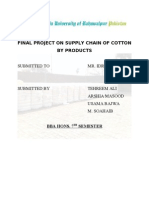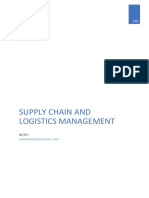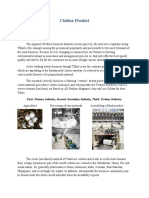Supply Chain PDF
Uploaded by
Laiba IsrarSupply Chain PDF
Uploaded by
Laiba IsrarSupply Chain
Supply chain refers to the network of organizations, individuals, activities, resources, and
technology involved in the creation and delivery of a product or service to the end customer.
The supply chain includes all the processes, from raw material sourcing to product delivery,
that are required to create value for the customer.
Supply Chain Stages
The cotton supply and value chain typically involves several stages, including farming,
ginning, spinning, weaving, dyeing/printing, and finishing. Each stage adds value to the cotton,
ultimately resulting in a finished product that can be sold to consumers.
1) Raw Material Sourcing:
The first stage in the cotton supply chain is the sourcing of raw cotton. Cotton is grown by
farmers in different regions of the country, and the cotton is harvested and transported to local
markets or directly to gin factories.
2) Ginning:
The second stage in the supply chain is the ginning process, where raw cotton is processed into
cotton lint. This stage involves the separation of seeds and other impurities from the cotton
fibers.
3) Spinning:
The next stage in the supply chain is spinning, where cotton lint is converted into yarn. The
spinning mills in Pakistan import raw cotton from different countries, including the United
States, Brazil, and Uzbekistan.
4) Weaving/Knitting:
The yarn produced in the spinning mills is then transported to weaving or knitting mills, where
it is turned into fabric. The weaving mills in Pakistan produce a variety of fabrics, including
denim, twill, and plain weave.
5) Dyeing/Printing:
The fabric is then transported to dyeing or printing mills, where it is treated with different
colors and designs. The dyeing and printing mills in Pakistan use both traditional and modern
techniques to produce high-quality fabrics.
6) Finishing:
The final stage in the supply chain is finishing, where the fabric is treated with different
chemicals and processes to improve its texture, durability, and appearance. This stage includes
processes like mercerizing, singeing, and calendaring.
7) Garment Manufacturing:
Once the fabric is finished, it is transported to garment manufacturing units, where it is cut,
sewn, and assembled into different types of garments, including shirts, trousers, and dresses.
8) Marketing and Distribution:
The final step is marketing and distribution. Textile products are marketed and sold to
customers through different channels, including retail stores, e-commerce platforms, and
wholesalers. The products are also exported to different countries, including the United States,
the European Union, and China.
Effective management of supply chain
Effective management of the supply chain is crucial for cotton companies in Pakistan. A well-
managed supply chain can help companies to reduce costs, improve quality, increase
efficiency, and enhance customer satisfaction. For example, if a cotton company can streamline
its supply chain, it can reduce the time it takes to deliver products to customers, thereby
increasing customer satisfaction. Additionally, if the company can reduce its raw material costs
by sourcing cotton from the most cost-effective suppliers, it can increase its profitability.
In Pakistan, the cotton industry faces various challenges such as low productivity, poor quality,
and inadequate infrastructure. Therefore, effective supply chain management is even more
crucial to overcome these challenges and create a competitive advantage. By optimizing the
supply chain, cotton companies in Pakistan can improve the quality of their products, reduce
lead times, and increase their ability to respond to changing customer demands.
Value Chain
The cotton industry value chain is the sequence of activities that a cotton company in the textile
industry uses to create value and deliver cotton-based products to customers.
The value chain includes both primary activities, such as production and marketing, as well as
support activities, such as procurement, research and development, and logistics. Effective
management of the value chain can help companies to create value for their customers, reduce
costs, and improve profitability.
Value chain stages
The cotton industry value chain is the sequence of activities that a cotton company in the textile
industry uses to create value and deliver cotton-based products to customers. The value chain
in the cotton industry includes the following steps:
1) Research and Development:
The first stage of the value chain is research and development, which involves the design and
development of new cotton products and processes.
2) Product Design:
Based on the research and development, the product design stage involves the creation of new
cotton products, such as garments, home textiles, and industrial textiles.
3) Marketing:
The marketing stage involves the promotion of the cotton products to potential customers,
including wholesalers, retailers, and end-users.
4) Distribution:
After marketing, the cotton products are distributed to different channels, such as wholesalers,
retailers, and e-commerce platforms.
5) Retail:
The retail stage involves the sale of cotton products to end-users through different channels,
such as brick-and-mortar stores, online platforms, and direct-to-consumer channels.
6) After-Sales Service:
The final stage in the value chain is after-sales service, which involves providing customer
support and service after the sale of cotton products.
Effective management of value chain
Effective management of the cotton industry value chain is crucial for creating high-quality
cotton products and delivering them to customers. By optimizing the value chain, cotton
companies can reduce costs, improve quality, and increase efficiency. By improving the quality
of raw cotton, cotton companies can produce high-quality yarn and fabric, which can increase
customer satisfaction and loyalty. Overall, effective management of the value chain can help
cotton companies to create a competitive advantage and increase their profitability.
You might also like
- Blank Sample WPS Form (GMAW & FCAW) Welding Procedure Specification (WPS)No ratings yetBlank Sample WPS Form (GMAW & FCAW) Welding Procedure Specification (WPS)1 page
- Introduction To Supply Chain Management: Logistics and S C M (TYBMS Sem - V) 32100% (1)Introduction To Supply Chain Management: Logistics and S C M (TYBMS Sem - V) 3214 pages
- Supply Chain Management Final SubmissionNo ratings yetSupply Chain Management Final Submission22 pages
- IBM Used Backward Placement To Improve Supply-Chain OperationsNo ratings yetIBM Used Backward Placement To Improve Supply-Chain Operations16 pages
- Mini Report On Textile Industry (ROSHNI JASUJA)No ratings yetMini Report On Textile Industry (ROSHNI JASUJA)14 pages
- Understanding The Cotton Supply Chain: MullerNo ratings yetUnderstanding The Cotton Supply Chain: Muller7 pages
- Unit 1 Introduction to Supply Chain and Logistics ManagementNo ratings yetUnit 1 Introduction to Supply Chain and Logistics Management19 pages
- Final Project Logistics and Coffee Supply ChainNo ratings yetFinal Project Logistics and Coffee Supply Chain25 pages
- Enterprise Resource Planning: Mid Term SubmisionNo ratings yetEnterprise Resource Planning: Mid Term Submision12 pages
- SWOT Analysis of Pakistan Textile Supply ChainNo ratings yetSWOT Analysis of Pakistan Textile Supply Chain8 pages
- Building Agri Supply Chains: Issues and GuidelinesNo ratings yetBuilding Agri Supply Chains: Issues and Guidelines18 pages
- Supply Chain Management of Textile Industry: A Case Study On BangladeshNo ratings yetSupply Chain Management of Textile Industry: A Case Study On Bangladesh6 pages
- Supply Chain Management of Textile IndusNo ratings yetSupply Chain Management of Textile Indus6 pages
- Tutorial 1 Questions - Global Logistic and Supply Chain ManagementNo ratings yetTutorial 1 Questions - Global Logistic and Supply Chain Management4 pages
- Feasibility Study For Cotton Spinning Mill100% (2)Feasibility Study For Cotton Spinning Mill122 pages
- Presented by Abid Rasheed, Salman Ilyas Ali Abrar, Nouman Shafi Adnan LaqueeNo ratings yetPresented by Abid Rasheed, Salman Ilyas Ali Abrar, Nouman Shafi Adnan Laquee16 pages
- What Is Supply Chain Management?: Application Service ProvidersNo ratings yetWhat Is Supply Chain Management?: Application Service Providers7 pages
- UNIT 1.3 - PROCUREMENT AND SUPPLY CHAIN DIPS 2 2025No ratings yetUNIT 1.3 - PROCUREMENT AND SUPPLY CHAIN DIPS 2 202537 pages
- Supply Chain Management & Logistics (SCML) : Department of Operation ManagementNo ratings yetSupply Chain Management & Logistics (SCML) : Department of Operation Management57 pages
- How to Learn Textile Design: Ultimate Step-by-Step Guide for Becoming a Textile DesignerFrom EverandHow to Learn Textile Design: Ultimate Step-by-Step Guide for Becoming a Textile DesignerNo ratings yet
- History of Smart Textiles: A Comprehensive Guide To E-TextilesFrom EverandHistory of Smart Textiles: A Comprehensive Guide To E-TextilesNo ratings yet
- Circular Fashion Management: Ideas, Perspectives and Tools to Catalyze Change ForewordFrom EverandCircular Fashion Management: Ideas, Perspectives and Tools to Catalyze Change ForewordNo ratings yet
- Only / Underline Format: Chapter C21 Site-Specific Ground Motion Procedures For Seismic DesignNo ratings yetOnly / Underline Format: Chapter C21 Site-Specific Ground Motion Procedures For Seismic Design17 pages
- Ledmedics Surgical Lights: Lighting CompetenceNo ratings yetLedmedics Surgical Lights: Lighting Competence16 pages
- Daily Updation Sheet- Bridge Works 27.12.2024No ratings yetDaily Updation Sheet- Bridge Works 27.12.20242 pages
- NCPPP Conference Standards and Guidelines For Speakers and ModeratorsNo ratings yetNCPPP Conference Standards and Guidelines For Speakers and Moderators3 pages
- course guide book -Product and Brand managment . 2015 - CopyNo ratings yetcourse guide book -Product and Brand managment . 2015 - Copy5 pages
- Proficy Hmi/Scada - Ifix: Mportant Product NformationNo ratings yetProficy Hmi/Scada - Ifix: Mportant Product Nformation47 pages
- MPPSC-PRE-2025-Set-A-GS-Paper-1-EnglishNo ratings yetMPPSC-PRE-2025-Set-A-GS-Paper-1-English12 pages
- UPS and Critical Power Solutions: General CatalogueNo ratings yetUPS and Critical Power Solutions: General Catalogue120 pages
- techspecs1_ab2dd9da-14fd-4b95-847a1724218169841_buyer55.ongcl.apNo ratings yettechspecs1_ab2dd9da-14fd-4b95-847a1724218169841_buyer55.ongcl.ap3 pages
- 1chemistry of Consumer Products (Autosaved)No ratings yet1chemistry of Consumer Products (Autosaved)37 pages
- EPAM Engineering KPI Dashboards For Hotel Industry Case StudyNo ratings yetEPAM Engineering KPI Dashboards For Hotel Industry Case Study5 pages

























































































